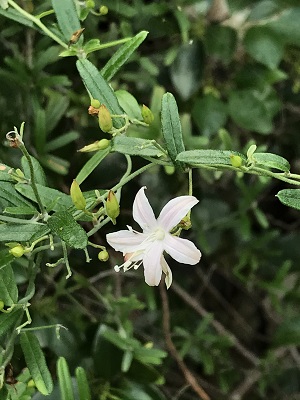Plants of South Florida · Plants by Conservation Area · Plants by County · Plants by Habitat Quick Search · Advanced Search |
||
|
|
||
 |
Jacquemontia havanensis (Jacq.)%20Urb. Havana%20clustervine |
|
|
South Florida Status: Critically imperiled. Two occurrences in two conservation areas (Bahia Honda State Park; Dagny Johnson Key Largo Hammocks Botanical State Park). Taxonomy: Dicotyledon; Convolvulaceae. Habit: Vine. Distribution: Native to South Florida, the West Indies, Mexico, and Central America. South Florida Distribution: Monroe County Keys. South Florida Habitats: Listed as endangered by FDACS and as critically imperiled by FNAI. Protection Status: Beach dunes, coastal berms, and edges of rockland hammocks. Aids to Identification: Nelson (1996) has a color photo; Chafin (2000) has illustrations and a color photo; the IRC Website has a color photo. References: Chapman, 1883; Small, 1933a; Robertson, 1971; Correll & Correll, 1982; Nelson, 1996; Wunderlin, 1998; Chafin, 2000; Coile, 2000; Liogier & Martorell, 2000; Gann et al., 2001. Synonyms: J. jamaicensis (Jacq.) Hallier f.; Convolvulus nodiflorus Desr., misapplied. Historical Context: Allan H. Curtiss first collected Havana clustervine in 1882 on Bahia Honda Key (s.n., US; 2171, NY), in what is now Bahia Honda State Park. Curtiss made a second collection there in 1896 (5646, NY). It also was collected there by John Kunkel Small in 1916 (7459, US), by Daniel B. Ward in 1964 (4308, USF), and by Bradley in 1995 (257, FTG). Gann and Bradley have both observed plants at Bahia Honda State Park. In 2001, Bradley and Florida Park Service biologist Janice A. Duquesnel mapped plants at Bahia Honda State Park (Gann et al., 2001a). Curtiss discovered the next station on Boca Chica Key in 1891 (s.n., GH). This station was vouchered only one additional time, by Robert W. Long, in 1966 (2142, USF). Bradley and Woodmansee surveyed Boca Chica Key in 2001, but failed to find any plants (Gann et al., 2001a). Curtiss may have collected it on No Name Key in 1896 (Robertson, 1971). We have not observed the specimen that Robertson reports (5631, G), but this is the same number used by Curtiss on a collection of J. pentanthos from No Name Key (5631, NY), which has been observed by Bradley. It seems likely that the Robertson report is in error. A specimen was possibly collected by Frank C. Craighead and George N. Avery on Big Pine Key in 1963 (s.n., Everglades National Park herbarium). Strangely, this location is not mentioned in Avery’s botanical notes, so this may represent a mislabeled specimen from Bahia Honda Key. Avery only recorded observing Havana clustervine on Bahia Honda Key in the lower Florida Keys. William G. Atwater collected Havana clustervine first on North Key Largo in 1959 (M-164, Everglades National Park herbarium). This station is within what is now Dagny Johnson Key Largo Hammocks Botanical State Park. Additional collections were made there by George N. Avery in 1971 (904, FTG, USF), and by Ruben P. Sauleda and Diane K. Sauleda in 1982 (7980, FTG, USF). Most of the plants at this station are growing along the edge of a hammock that is divided by the intersection of Card Sound Road and State Road 905. It was not clear exactly what the natural habitat was for this species on North Key Largo until 2000, when Gann and Duquesnel found additional plants in the ecotone between Crossroads Hammock, immediately to the north of the main station, and Dispatch Slough to the east. Plants at Key Largo Hammock State Botanical Sites were mapped in 2001 by Gann, J.A. Duquesnel, Florida Park Service biologist James G. Duquesnel, and Fairchild Tropical Garden biologists Megan Fellows and Jennifer Possley (Gann et al., 2001b). Major Threats: Exotic pest plant invasions; sea-level rise. Comments: A specimen cited by Robertson (1971) from Virginia Key in Miami-Dade County, collected by Simpson (544, F), is actually a specimen of J. reclinata. Recommendations: • Map and monitor known stations on a regular basis. |
||



